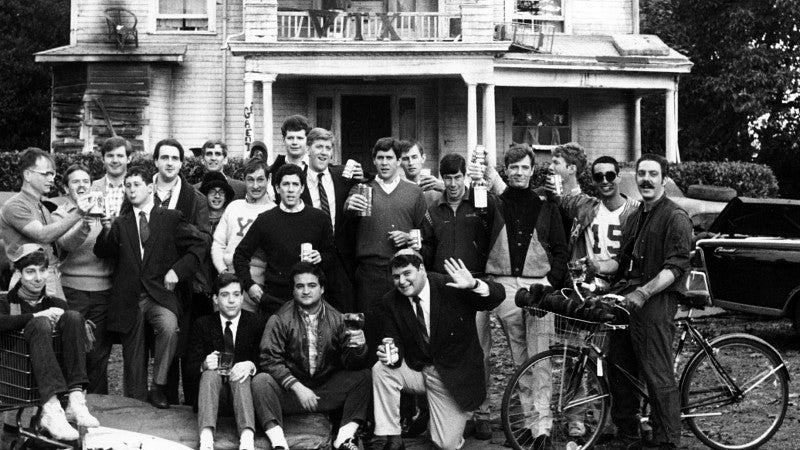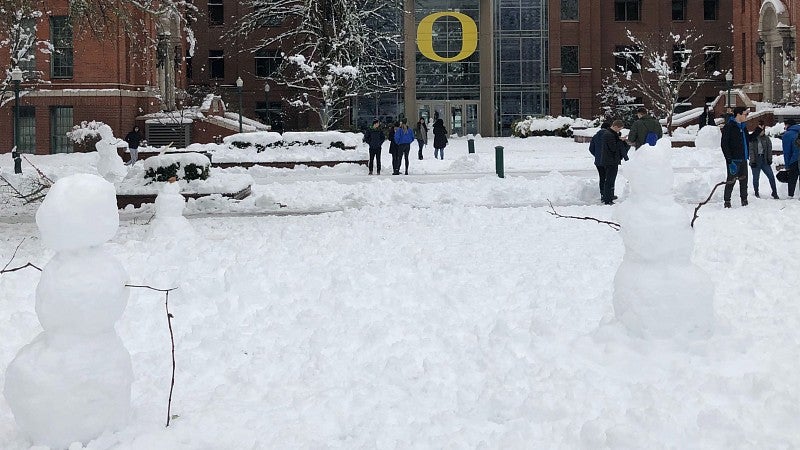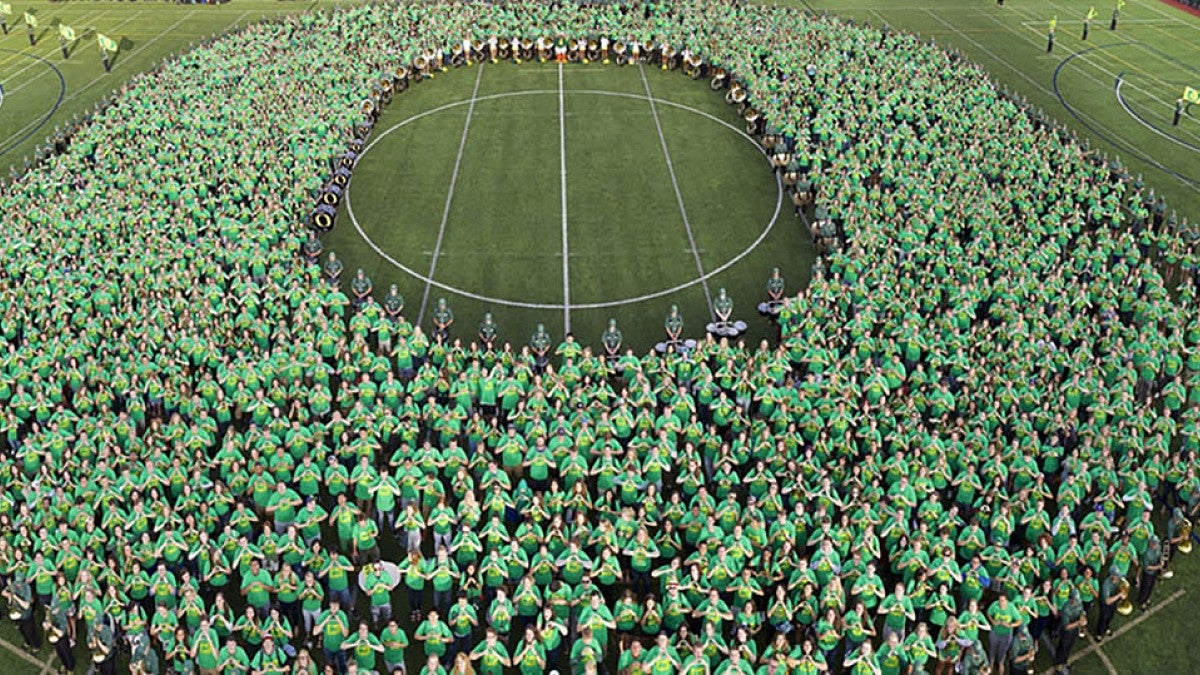Endings always provide a prime time for reflection, and as this year ends, what better time to look back to where it all began and what has transpired since:
Research, breakthroughs and accomplishments by our students, staff and faculty members.
A historic season for the women’s basketball team. An epic snowstorm that slowed, but didn’t completely stop, an entire campus.
Groundbreaking for the Black Cultural Center, and breaking ground by PathwayOregon students.
Yes, 2018-19 was full of excitement.

Summer
Even though it’s much quieter, campus wasn’t completely dormant when most students were away.
Campus looked back on “Animal House” as the still-popular comedy that was famously filmed here turned 40, speaking with students from back then and those on campus today, along with faculty members, to examine how the edgy movie has aged.
Several faculty members delved into the brains of teenagers, especially their ability to control impulses when it comes to engaging in risky pursuits. Two faculty members also held Quack Chat pub talks on unravelling the mystery of the teenage brain.
The Robert J. DeArmond Trust graciously donated $10 million to create a permanent research fund in the form of an endowment for the executive director of the Phil and Penny Knight Campus for Accelerating Scientific Impact. The gift also will support efforts to recruit senior faculty members and accelerate research at the innovative science facility.

Fall
Fall term began by welcoming the most diverse and academically strong class in the history of the university, one-third of which were the first in their family to attend college.
The university also marked 10 years of PathwayOregon with its largest class ever. The program covers the costs of college for low-income Oregonians. It’s not only one of the first of its kind in the nation, it’s also highly successful at helping them graduate.
With help from a partnership with the Stamps Family Charitable Foundation, campus also welcomed the largest class of Stamps Scholars in 2018.
The Educational and Community Supports Unit in the College of Education received a $32.6 million grant — what is believed to be the largest grant ever awarded to the university — that allows it to continue its work helping teach students with disabilities. The funds help support the Positive Behavioral Interventions and Supports network, a program found in more than 26,000 schools across the country that emphasizes encouraging good classroom behaviors over punishing undesirable behavior.
In a weekend that will be looked back as historic, the UO hosted its first-ever Black Alumni Reunion, held the inaugural Black Student Convocation and celebrated with a groundbreaking ceremony for the university’s Black Cultural Center.
Coming in on the heels of the ASUO Street Faire, the UO partnered with the city of Eugene for an expanded block party that brought together members of the campus community with local neighbors for a fun-filled afternoon.
The university strengthened its connection with downtown Eugene with the opening of 510 Oak, the UO’s new, off-campus art building. Housing College of Design faculty members, the space will serve as the new home for art and product design research studios and the Center for Art Research.
UO researchers received a five-year, $12.5 million grant that will allow them to play a key role in a landmark National Institutes of Health initiative that tracks the effects of environmental exposures on children’s health and development. Researchers will collect data from 1,000 children and their families to examine everything from obesity to neurodevelopment to positive health outcomes.
Ray Atkeson famously chronicled the Northwest with iconic photos from Mount Hood to Cannon Beach as well as the UO campus. Thanks to a generous gift from the photographer’s stepson, the Ray Atkeson Photography Collection — with more than a quarter of a million images capturing the region's people and landscapes over several decades — is now part of the UO Libraries' Special Collections and University Archives.
Building on strong momentum of a successful $2 billion fundraising campaign, in September President Michael Schill announced the university would add another $1 billion to the effort.
Campus was wide awake and rocking on a pre-dawn Saturday as ESPN College Gameday returned to town for the first time since 2014 as the Ducks took on Stanford.
Justin Gallegos, a junior studying journalism and a member of the UO Running Club, became the first professional Nike athlete with cerebral palsy when he signed a contract with Nike to become a professional runner last October.
Paleontologists at the Museum of Natural and Cultural History reported the discovery of a land-dwelling dinosaur’s fossilized bone in Eastern Oregon — a rare find since Oregon was underwater throughout most of the dinosaur age.
Thanks largely to the Master’s Industrial Internship Program — the first official program based in the Phil and Penny Knight Campus for Accelerating Scientific Impact — the University of Oregon granted more master’s degrees in physics than any other university in the country in 2017, earning a top ranking in a report recently released by the American Institute of Physics.
Carol Gering became the UO’s new associate vice provost of online and distance education and will lead Oregon’s efforts at establishing a solid platform for online education.
Diego Melgar, a professor of earth sciences, published research that gave a clearer picture into the source of some earthquakes, including the Cascadia fault off the West Coast, that one day could help scientists give advance warning when The Big One strikes.
Ducks helped build the foundation for a landmark climate lawsuit and examined wildfires and landslides in the Pacific Northwest with research in the Columbia River Gorge.

Winter
One of the biggest stories of the year was a pair of snowstorms that slammed campus within a couple days of each other. And while classes were canceled or delayed for a few days, thanks to hardworking campus and facilities staff, the university never completely shut down.
Ducks who have ever taken a course with Stan Micklavzina would remember him and his distinctive style of teaching. His efforts at bringing science to the masses also caught the eye of Lund University in Sweden, which awarded him an honorary doctorate.
The School of Journalism and Communication launched a new master of advertising and brand responsibility degree, the first graduate degree of its kind.
The president funded a new set of fellowships to support faculty members in the arts and humanities in their research or creative projects. The $13,000 awards will be granted to faculty members in the College of Arts and Sciences, the College of Design, the School of Journalism and Communication, and the School of Music and Dance.
A high-tech table at the Allan Price Science Commons and Research Library, billed as the world’s first virtual dissection table, was gifted to the Department of Human Physiology in the spring by UO alumnus Samuel Blackwell, a retired Redmond physical therapist, and his wife, Linda. Users can zoom into and study body parts and learn how they are interconnected.
The College of Education and School of Law were ranked among the top graduate schools in the nation in U.S. News & World Report’s ranking for 2020. The College of Education ranked 14th in the country overall for education graduate programs, while three School of Law programs rank in the top 10.
The women’s basketball team recorded a historic season, advancing all the way to the Final Four in Tampa Bay with superstar Sabrina Ionesco picking up multiple national honors along the way. Meanwhile, the men’s team exceeded the expectations of many prognosticators with a magical run that ended in the Sweet 16. The UO Unified Basketball Team also earned a bid to its national tournament in Kansas.

Spring
Hiring ramped up for the Knight Campus this spring, with faculty members whose specialties include blending biology with physical sciences and engineering and a neuroengineer with a track record of success in academics and commercialization, among others.
Construction around campus also ramped up, with work underway at six buildings throughout the spring that will help shape the future of the university, including Hayward Field.
Prominent UO alumni Phyllis and Andrew Berwick, who have previously given generously to the UO, gave $5 million to establish an endowed deanship at the School of Music and Dance.
Thanks to an anonymous pledge of $3.5 million that will fund endowed chairs in the College of Design and the College of Arts and Sciences, the deans of each college revealed plans to promote collaborations in the closely linked fields of urban design and urban economics. The gift, which honors two influential UO professors, will create the W.R.B. Willcox Chair in Urban Design and the Ed Whitelaw Chair in Urban Economics.
Things were buzzing at the Erb Memorial Union after several campus groups collaborated to install a bee hive on top of the building.
Ben Saunders, co-founder and director of the comic studies program and an English professor, had an exhibit celebrating Marvel Comic’s 80 years of publishing history at museums in Seattle and Philadelphia.
Law school alumna Katherine “Katie” Staton turned to the Many Nations Longhouse to find a community of support and connection with the local Native community during her time as a student. She returned this spring as the new steward of the longhouse.
UO star chemist Geri Richmond received Oregon State University’s prestigious Linus Pauling Legacy Award. The award recognizes an individual who has made significant contributions in a subject of interest to Pauling.
Also, three undergraduates were awarded Goldwater Scholarships, and the largest cohort in UO history earned Gilman scholarships.
As the year wound down, biologist Patrick Phillips was chosen as the new provost. Phillips previously served as acting executive director of the Knight Campus.
The university also announced a historic partnership between the UO’s Knight Campus and Oregon Health & Science University’s Knight Cancer Institute for a joint center in biomedical data science, empowering researchers at both institutions to attack cancer with big data.
Lastly, the year concluded with commencement, the traditional exclamation mark on what was a most memorable year.
—By Jim Murez, University Communications


